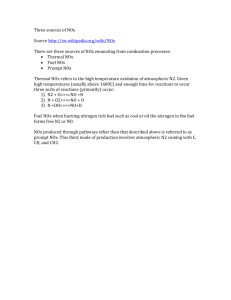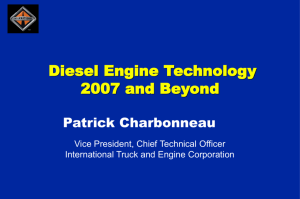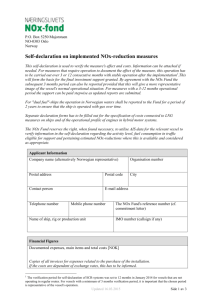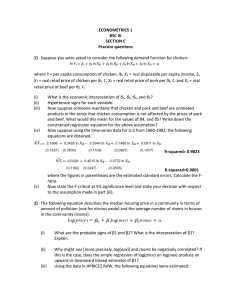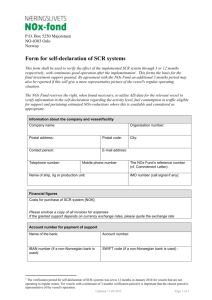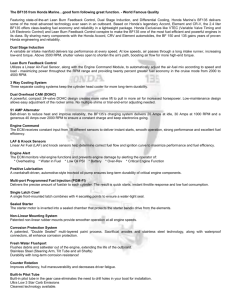HC-SCR CATALYST FOR NO REDUCTION IN AN OFF-ROAD DIESEL ENGINE
advertisement
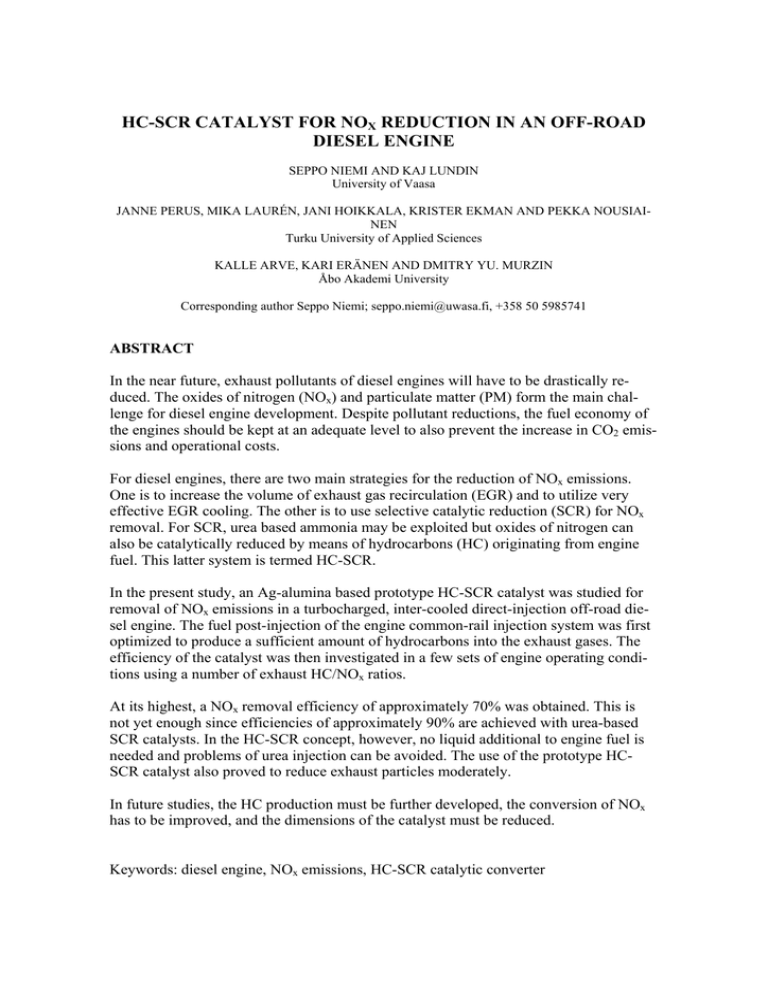
HC-SCR CATALYST FOR NOX REDUCTION IN AN OFF-ROAD DIESEL ENGINE SEPPO NIEMI AND KAJ LUNDIN University of Vaasa JANNE PERUS, MIKA LAURÉN, JANI HOIKKALA, KRISTER EKMAN AND PEKKA NOUSIAINEN Turku University of Applied Sciences KALLE ARVE, KARI ERÄNEN AND DMITRY YU. MURZIN Åbo Akademi University Corresponding author Seppo Niemi; seppo.niemi@uwasa.fi, +358 50 5985741 ABSTRACT In the near future, exhaust pollutants of diesel engines will have to be drastically reduced. The oxides of nitrogen (NOx) and particulate matter (PM) form the main challenge for diesel engine development. Despite pollutant reductions, the fuel economy of the engines should be kept at an adequate level to also prevent the increase in CO2 emissions and operational costs. For diesel engines, there are two main strategies for the reduction of NOx emissions. One is to increase the volume of exhaust gas recirculation (EGR) and to utilize very effective EGR cooling. The other is to use selective catalytic reduction (SCR) for NOx removal. For SCR, urea based ammonia may be exploited but oxides of nitrogen can also be catalytically reduced by means of hydrocarbons (HC) originating from engine fuel. This latter system is termed HC-SCR. In the present study, an Ag-alumina based prototype HC-SCR catalyst was studied for removal of NOx emissions in a turbocharged, inter-cooled direct-injection off-road diesel engine. The fuel post-injection of the engine common-rail injection system was first optimized to produce a sufficient amount of hydrocarbons into the exhaust gases. The efficiency of the catalyst was then investigated in a few sets of engine operating conditions using a number of exhaust HC/NOx ratios. At its highest, a NOx removal efficiency of approximately 70% was obtained. This is not yet enough since efficiencies of approximately 90% are achieved with urea-based SCR catalysts. In the HC-SCR concept, however, no liquid additional to engine fuel is needed and problems of urea injection can be avoided. The use of the prototype HCSCR catalyst also proved to reduce exhaust particles moderately. In future studies, the HC production must be further developed, the conversion of NOx has to be improved, and the dimensions of the catalyst must be reduced. Keywords: diesel engine, NOx emissions, HC-SCR catalytic converter INTRODUCTION The main challenge of diesel engine development is the simultaneous reduction of NOx and PM emissions (oxides of nitrogen and particulate matter, respectively). Additionally, the fuel economy has to be kept at a high level (Greene 2008). The emissions legislation is becoming more stringent very rapidly. In addition to onroad vehicle engines, emissions must be drastically reduced in the engines of off-road machines. Moreover, new emissions standards will also be imposed on marine diesel machineries that so far have been able to emit large pollutant quantities. Efficient and feasible exhaust after-treatment devices will thus be abundantly needed in all sectors utilizing diesel engines as prime movers. In diesel engines, the reduction of NOx emissions usually results in increased PM emissions, as also illustrated in Figure 1 for NOx and smoke in a conventional diesel engine with in-line injection pumps. Additionally, the decrease of NOx generally leads to increased fuel oil consumption. These trade-off phenomena, also presented schematically in Figure 2, make the engine development very challenging. 1500 rpm, 75% load 18% 4 17% Smoke (FSN) 3.5 17 16% 16% 19 21 3 12% 10% 2.5 10% 2 0% 0% 1.5 0% 1 300 500 700 900 1100 1300 NOx (ppm,wet) Figure 1: Trade-off between exhaust smoke and NOx at 75% load at intermediate speed in an off-road diesel engine; three static injection timings (17°, 19° and 21°) and various EGR rates (0% to 18%) Currently, there are two main optional strategies for fulfilling the demands of the nearest emissions legislation phase, e.g. those of the US Tier 4i entering into force in 2011 for off-road engines with an output of more than 130 kW. One will utilize cooled EGR and a highly-efficient wall-flow diesel particulate filter (DPF) plus advanced turbocharging. The other relies on the use of a catalyst based on selective catalytic reduction of NOx (SCR) and an open-flow partial filter for particulates (pDPF). A high injection pressure is required for both options. Figure 2: Schematic diagram about soot, NOx and CO2 emissions in diesel engines as a function of the flame temperature (Lundgreen 2008) With regard to the next phase, e.g. the US Tier 4 in 2014, it seems that all this equipment will be needed, i.e. cooled EGR, SCR catalyst and filter. The injection pressure must be further increased and efficient turbo-charging has to be exploited. The NOx reducing SCR catalysts are divided into two groups. In the HC-SCR converters, oxides of nitrogen are reduced by means of hydrocarbons (HC). In the NH3-SCR catalysts, the reduction is conducted by means of ammonia, in practical solutions with urea. Urea or ammonia based SCR catalysts have already been used in power plants for decades and the number of urea based systems increases rapidly in heavy duty vehicles. NH3-SCR catalysts are efficient, Figure 3, and a NOx reduction of more than 90% is possible even though in highly-transient vehicle applications somewhat lower overall reductions are more realistic. 4 1200 2 800 NOx [g/kWh] 3 1600 Urea flow rate [cm /h] Intermediate speed, high load 6 0 400 0.4 0.7 0.8 1 Mole ratio NH3/NOx Figure 3: Brake specific NOx emissions of a conventional off-road diesel engine downstream a urea-SCR catalyst against the exhaust mole ratio of ammonia and NOx; approximate urea consumption also presented; (in-line fuel injection pumps) Nevertheless, urea- or ammonia-based SCR catalysts require an additional fluid to be tanked into vehicles and off-road machines. Particularly the latter ones work outside the ordinary infrastructure for long periods, which makes the maintenance demanding compared to on-road vehicles. In mobile applications, the injection of urea also seems to be somewhat complex possibly causing some control and maintenance problems. Experiences from ships indicate that urea-SCR catalysts may cause clogging and the back-pressure increases. Various theories have been presented to explain this phenomenon but fuel sulphur most likely plays a big role, this being advantageous for off-road engines utilizing low-sulphur fuels, however. (Lundgreen 2008) Jokinen (2008) assesses that urea prices are likely to remain volatile and at a high level when compared with recent years; AdBlue-prices will, however, be below the diesel fuel oil prices. Johnson (2008) points out that urea comes from natural gas feedstock and the processing involves an innate CO2 penalty. With a 5% urea consumption rate relative to fuel, the urea total CO2 contribution is said to be approximately 10 to 15%. The second option, the HC-SCR catalysts are able to utilize fuel-derived hydrocarbons for NOx reduction, which simplifies both the maintenance and machine lay-outs since no additional fluid is required. During the last two decades, the research on HC-SCR catalysts has been intensive and several catalytic formulations have been suggested for the HC-SCR of NO. Among these, Ag/alumina has shown high activity both in laboratory studies and in full-scale tests when applied to a diesel-driven passenger car (Arve et al. 2007, Klingstedt et al. 2006). The performance of the HC-SCR catalysts has, however, not yet reached that of the ammonia- or urea-based SCR converters. Eränen (2004) reports an average conversion of 72% obtained with a 5-cylinder direct-injection passenger car diesel engine equipped with a common-rail injection system. The temperature was then 400 ˚C and the HC1/NOx ratio was 6. A fuel penalty of 3 to 4% was detected. Just the increase in fuel consumption forms another drawback of the HC-SCR system. For comparison, van Basshuysen and Schäfer (2006) give a fuel penalty estimation of 2 to 4%. Of course, the additional fuel costs must be compared with those caused by the urea consumption in the NH3-SCR systems that is said to be approximately 3 to 5% of the fuel consumption. Another challenge in HC-SCR systems is the arrangement of the HC production. A separate fuel injection into the exhaust pipe upstream the converter is one option but it means additional equipment and control systems. In advanced common-rail systems, the HCs can be generated already in the cylinder adopting a late enough post-injection. Fuel may, however, impinge on liner walls and lubricating oil may deteriorate faster than usually. The composition of the HCs can also vary with the engine operating conditions which may affect the efficiency of the HC-SCR catalyst (Eastwood 2000). In the present study, an Ag/alumina based prototype HC-SCR catalyst was studied in conjunction with two off-road diesel engines of different sizes. Hydrocarbons were added into the exhaust already in the engine cylinder by utilizing the post-injection of the common-rail fuel injection systems. The aim of the study was to determine and optimize the performance of the prototype HC-SCR converter. The timing and fuel quantity of the post-injection were examined. The performance of the catalytic converter was analyzed with regard to gaseous emissions and particulates and also by looking at changes in fuel consumption. The results were finally compared with those achieved with cooled EGR. The catalytic converter was delivered by the Åbo Akademi University in co-operation with the monolith manufacturer and engine supplier. The engine experiments were performed at the IC engine laboratory of Turku University of Applied Sciences. EXPERIMENTAL SETUP Test engines Two different turbocharged, intercooled off-road diesel engines were used in the study. Both engines were equipped with common-rail injection systems. The larger engine had a four-valve cylinder head, while a conventional two-valve head was used in the smaller one. The study was initiated adopting the larger 6-cylinder engine. The exhaust mass flow rate proved, however, too high for the prototype catalyst and the exhaust back-pressure increased excessively. The post-injection timing possibilities of the 6-cylinder engine were also too limited. Some preliminary tests were therefore only performed with this engine and the main study was conducted with the smaller 3-cylinder 33 CTA 2V engine. The main specification of the 3-cylinder test engine is given in Table 1. Table 1: Test engine specifications Manufacturer Engine Cylinder number Agco Sisu Power 33 CTA 2V 3 Bore 108 mm Stroke 120 mm Swept volume 3.3 dm3 Turbocharger Schwitzer S100 Rated power 75 kW / 2200 rpm Maximum torque 400 Nm / 1600 rpm The post-injection phase of the five-shot common-rail injection system was exploited for producing extra hydrocarbons into the exhaust gases. The timing and fuel quantity of the post-injection could be varied within large ranges. Fuels Low-sulphur diesel fuel oils were used in the study. In the main tests with the 3-cylinder engine, the fuel contained 6 mg/kg sulphur, 29.8% aromatic compounds, and less than 0.001% ash. In the preliminary measurements, the fuel S content was 10 mg/kg, the content of aromatic compounds was 32.9% and that of ash < 0.001%. Catalytic converter An Ag/alumina catalyst was prepared by impregnation of commercial alumina beads (A-201, LaRoche Industries Inc.) with a 0.022M silver nitrate solution of high purity (J.T. Baker) for 24 hours resulting in approximately 2 mass-% of silver in the catalyst. The catalyst was dried first at room temperature and thereafter at 100 °C followed by calcination at 550 °C for 3 hours. For the engine bench tests, the catalyst was wash-coated on four cordierite monolith bricks by Johnson Matthew • 400 cpsi • 2.5 g/in3 • 10″ x 6″ The bricks were arranged in a converter with free space between each monolith. Additionally, an oxidation catalyst (Johnson Matthew) for CO and unburned hydrocarbons was placed downstream from the SCR catalysts. Figure 4 depicts the catalyst and the engine installation. Figure 4: Experimental setup; the catalytic converter on the left Analytical procedures The engine was run in a laboratory test cell and loaded by means of an eddy-current dynamometer. Different parameters and factors were analyzed as follows: • intake air flow was calculated based on the fuel flow rate and exhaust composition • DFO flow rate by means of a Coriolis mass flow meter • charge and exhaust pressures by piezoelectric pressure transducers • exhaust temperatures by K type thermocouples (NiCr-Ni) Gaseous exhaust components, smoke and particle size distributions were determined by means of analyzers, listed in Table 2. Table 2: Analyzers for exhaust measurements Substance Manufacturer Model Paramagnetic sensor O2 CO Technology Servomex Xentra 4900 HC CAI 300-HFID NO, NO2 Eco Physics CO2 Non-dispersive infrared (NDIR) Flame ionization detector (HFID) CLD 700EL ht Chemiluminescent detector (CLD) Smoke AVL 415 S G002 Optical Filter PM (number) Dekati Ltd ELPI Electrical low-pressure impactor In the ELPI measurements, a transient sample probe was used. The exhaust was diluted with air at two stages before the analyzer. The first diluter was insulated and heated to a temperature of 200 °C. Heated dilution air was led to this initial diluter, the set value for air being 200 °C. The uninsulated second diluter was not heated, and air at approximately ambient temperature was used as dilution medium. The dilution ratio was defined as the ratio of the NOx content in raw exhaust and in the double-diluted gas. Particles with an aerodynamic diameter down to 21 nm could be detected. The largest measured particle category had an aerodynamic diameter of 775 nm. At the beginning of each test day, the instrumentation and engine were first warmed up. The engine was then set at the selected test speed and load and allowed to stabilize before taking gaseous and particulate samples and recording operational parameters and performance results. Experimental matrix The main study with the 33 CTA 2V engine was started by optimizing the post-injection timing and quantity. The aim was to produce plenty of extra hydrocarbons into the exhaust gases but at an as low as possible fuel consumption penalty. Thereafter, the NOx reduction performance of the catalyst was determined. Finally, the HC-SCR results were compared with those obtained by conventional methods, e.g. cooled EGR and without any catalyst. The measurements were performed at three engine speeds, Table 3. The load percentages were calculated from the maximum torque of each speed. Table 3: Experimental matrix Speed Loads rpm % 1200 50 and 100 1600 50, 75 and 100 2200 50 RESULTS Timing of post-injection The timing of the post-injection phase was first studied at 1200 rpm and at 2200 rpm by setting the post-injection quantity at 2 mg. The timing was retarded in steps of 30° starting at 90° after top dead center (ATDC). Figure 5 shows that the timing 120° ATDC proved the best one for 50% load at 1200 rpm whereas 150° ATDC was better for full load at this speed and for 50% load at 2200 rpm. - At 1600 rpm, the post-injection timing of 150° ATDC was used at all loads. Post-injection fuel quantity 2 mg 8 HC1/NOx 6 2200 rpm/50% 1200 rpm/50% 4 1200 rpm/100% 2 0 90 120 150 180 Post-injection timing [°ATDC] Figure 5: Exhaust HC1/NOx mole ratio versus post-injection timing at three engine loads Quantity of post-injection As illustrated in Figure 5, the HC1/NOx ratio remained low, below 2, at all timings at 1200 rpm. It has been estimated that an optimum ratio would be approximately six [Eränen 2004]. Therefore, the post-injection quantity was next increased at the selected injection timings in order to increase the HC1/NOx ratio and to be able to investigate the catalyst performance against the hydrocarbon richness. Figure 6 depicts how the HC1/NOx ratio developed with increasing post-injection fuel quantity. At half load, a steady increase was detected and an HC1/NOx ratio of above 8 was measured with a post quantity of 10 mg. At full load, however, the HC1/NOx ratio did not increase as beneficially. It remained below 5 even with a post-injection shot of 20 mg. 1200 rpm 9 50%; 120° ATDC 8 100%; 150° ATDC 7 HC1/NOx 6 5 4 3 2 1 0 0 5 10 15 20 Post-injection quantity [mg] Figure 6: HC1/NOx ratio versus post-injection fuel quantity at two loads at 1200 rpm; optimum post-injection timings At 1600 rpm at 50% load, an HC1/NOx ratio of approximately 10 was recorded with a post-injection fuel quantity of 10 mg, Figure 7. At higher loads, the ratio remained lower. Nevertheless, an HC1/NOx ratio of slightly below 8 was measured at 75% load and 7.6 at full load. The post-injection fuel shots were then 15 and 20 mg, respectively. 1600 rpm; post-injection timing 150° ATDC 10 HC1/NOx 8 6 4 50 % 75 % 2 100 % 0 0 5 10 15 20 Post-injection quantity [mg] Figure 7: HC1/NOx ratio with different post-injection fuel quantities at three loads at 1600 rpm At 50% load at 2200 rpm, the exhaust HC content did not increase with post-injection fuel quantity but was approximately constant within the quantity range of 4 to 8 mg. NOx reduction performance The reduction of NOx emissions improved with the increasing mole ratio of hydrocarbons and nitrogen oxides under all engine loading conditions studied. Almost linear dependencies were detected even though the catalyst performance seemed to improve slightly faster at minor HC1/NOx ratios. At 1200 rpm, a NOx reduction of approximately 70% was obtained at half load when the HC1/NOx ratio was 8.4, Figure 8. At full load, the conversion was lower than at 50% load within the entire HC1/NOx ratio range. An approximate NOx reduction of 42% was achieved at an HC1/NOx ratio of 4.7. 1200 rpm -80 Change in NOx [%] -70 -60 -50 -40 -30 -20 50% load -10 100% load 0 0 1 2 3 4 5 6 7 8 9 HC1/NOx Figure 8: Change in NOx emissions against the HC1/NOx ratio at 1200 rpm At 1600 rpm, the NOx reduction also improved with decreasing load, Figure 9. At half load, the highest NOx reduction of 56% was measured at an HC1/NOx ratio of approximately 10. At 75% load, the performance topped at 42% with an HC1/NOx ratio of 8.0. At full load, the best reduction efficiency was 35% at an HC1/NOx ratio of 7.6. At half load at the highest speed of 2200 rpm, the NOx reduction remained at approximately 29% with HC1/NOx ratios of 6.6-7.3, Figure 10. 1600 rpm -60 Change in NOx [%] -50 -40 -30 -20 50% load -10 75% load 100% load 0 0 2 4 6 8 10 HC1/NOx Figure 9: Change in NOx emissions versus mole ratio of hydrocarbons and oxides of nitrogen at three loads at 1600 rpm 2200 rpm, 50% load -40 Change in NOx [%] -35 -30 -25 -20 -15 -10 -5 0 0 2 4 6 8 HC1/NOx Figure 10: NOx reduction versus exhaust HC1/NOx ratio at 50% load at 2200 rpm Fuel consumption Inevitably, fuel post-injection for extra HC production increases engine fuel consumption. At full load at 1200 rpm, the relative increase in brake specific fuel consumption (BSFC) was 6.8% at the highest NOx reduction of 39%, Figure 11. At half load, the fuel penalty was slightly lower at a given NOx reduction performance but at the top value of 70% NOx decrease the BSFC increased by up to 13%. At 2200 rpm half load, a reduction in NOx by 30% led to a BSFC increase of approximately 5%. At 1600 rpm, the relative increase in BSFC was the more moderate the lower the load, Figure 12. At half load, a fuel penalty of 6.8% resulted in a BSNOx reduction of 58% while at 75% load a 44% decrease was obtained at a fuel penalty of 7.0%. At full load, a 7.8% fuel consumption increase generated a BSNOx reduction of 36%. The differences in relative BSFC increase between the loads were thus greater than at 1200 rpm. 14 12 Increase in BSFC [%] 10 8 6 4 1200 rpm/100% 2 1200 rpm/50% 2200 rpm/50% 0 0 -10 -20 -30 -40 -50 -60 -70 Change in BSNOx [%] Figure 11: Fuel penalty against NOx reduction performance at different loads at 1200 and 2200 rpm 1600 rpm Increase in BSFC [%] 8 6 4 100 % 2 75 % 50 % 0 0 -20 -40 -60 Change in BSNOx [%] Figure 12: Increase in brake specific fuel consumption (BSFC) versus decrease of brake specific NOx (BSNOx) at three loads at 1600 rpm Hydrocarbon slip When producing excess hydrocarbons for NOx reduction, one should also ensure that the HC emissions of the engine do not increase. In the present study, the HC-SCR catalytic converter also comprised one oxidation brick for HC removal. The performance of this oxidation catalyst was excellent. In the worst case, i.e. at 50% load at 2200 rpm, the brake specific HC (BSHC) emission decreased by 86% when post-injection was off, Figure 13. Within the post-injection quantity range of 2 to 8 mg, the oxidation catalyst reached a reduction efficiency of more than 96%. 2200 rpm/50% -100 Change in BSHC [%] -96 -92 -88 -84 -80 0 2 4 6 8 Post-injection fuel quantity [mg] Figure 13: Reduction of BSHC emissions at various post-injection fuel quantities at half load at 2200 rpm COMPARISON OF THE HC-SCR STRATEGY WITH AN EGR SYSTEM The performance of the prototype HC-SCR catalyst was compared with what was obtained in the same engine using cooled exhaust gas recirculation (EGR). A short-route EGR system was utilized. Gas from the exhaust manifold was led through a cooler into the intake manifold, as illustrated in Figure 14. The flow was controlled by means of an electric on-off valve, mounted close to the intake manifold. When using the HC-SCR converter, the EGR valve was closed. Figure 14: EGR system of the experimental engine. Ilma, air; pakokaasu, exhaust gas; ahtoilman jäähdytin, charge air cooler; venttiili, valve; jäähdytin, cooler; turboahdin, turbocharger; imuilma, intake air For both systems, results were only available for the speed 1600 rpm. First, exhaust gas back-pressures were studied. They were very similar at part loads, but at full load the EGR version generated a slightly higher back-pressure than the HC-SCR concept (11 kPa against 9 kPa). With HC-SCR, the back-pressure increased by approximately 8% at full load when the highest post-injection quantity was used instead of no post-injection. NOx reduction performance Figure 15 depicts how both concepts reduced the brake specific NOx emissions of the engine at 1600 rpm. First, the closing of the EGR valve increased BSNOx at full load by 28%. When switching the post-injection on and using the highest fuel quantity in HCSCR, the BSNOx, however, decreased significantly. Relative to EGR, a reduction of 12% was detected. At part loads, the differences in BSNOx between the EGR and HCSCR strategies were greater; a decrease by 22% was recorded at 75% load and at half load, the reduction was 40%. 1600 rpm Relative BSNOx 1.1 0.9 0.7 0.5 0.3 40 50 60 70 80 90 100 110 Load [%] EGR SCR, 0 mg/str SCR, 2 mg/str SCR, max post Figure 15: Relative brake specific NOx emissions at different loads at 1600 rpm with EGR and HC-SCR; post-injection quantity as parameter for HC-SCR Hydrocarbons and smoke The prototype HC-SCR converter also included an oxidation catalyst brick for elimination of possible excess hydrocarbons. Therefore, the HC-SCR concept was superior to the EGR one with respect to HC emissions, as also illustrated in Figure 16. At full load, however, the difference was minor in the case of the maximum post-injection quantity. The use of the HC-SCR catalyst also reduced smoke, Figure 17. Now, the increase in post-injection quantity did not deteriorate the results. In fact, smoke slightly decreased at half load with the maximum post-injection fuel shot. On the whole, one must point out that smoke was also moderate with EGR. Fuel consumption The use of post-injection for production of reductant hydrocarbons increases fuel consumption. When the EGR valve was closed and HC-SCR catalyst installed into the exhaust pipe, the brake specific fuel consumption slightly decreased, Figure 18. Switching post-injection on, however, increased fuel consumption and with the highest post-injection quantity, the BSFC was higher by 6 to 7% compared with the EGR concept. Particle size distributions At all loads, the use of the EGR strategy generated more exhaust particles within the entire particle size range compared with the use of the HC-SCR converter. At some large particle categories (200, 310, 480 nm, approximately), the difference was one or- der of magnitude or more. Figure 19 shows the brake specific particle emissions for half load at 1600 rpm. 1600 rpm 1.05 Relative BSHC 0.85 0.65 0.45 0.25 0.05 40 50 60 70 80 90 100 110 Load [%] EGR SCR, 0 mg/str SCR, 2 mg/str SCR, max post Figure 16: Relative brake specific hydrocarbon emissions versus engine load at 1600 rpm with EGR and HC-SCR concepts 1600 rpm Relative smoke 1.1 0.9 0.7 0.5 0.3 40 50 60 70 80 90 100 110 Load [%] EGR SCR, 0 mg/str SCR, 2 mg/str SCR, max post Figure 17: Relative exhaust smoke at various engine loads at 1600 rpm with two emissions reduction systems 1600 rpm 1.02 Relative SFC 0.99 0.96 0.93 0.90 0.87 40 50 60 70 80 90 100 110 Load [%] EGR SCR, 0 mg/str SCR, 2 mg/str SCR, max post Figure 18: Relative brake specific fuel consumption against engine load at 1600 rpm with EGR and HCSCR; HC-SCR system with various post-injection dosages 1600 rpm / 50% load 1.E+12 EGR SCR, 0 mg SCR, 2 mg SCR, 10 mg BSPM (1/kWh) 1.E+11 1.E+10 1.E+09 1.E+08 10 100 1000 Aerodynamic diameter (nm) Figure 19: Brake specific particulate matter (BSPM) emissions versus particle aerodynamic diameter at 50% load at 1600 rpm with two emissions reduction concepts Within the ultra-fines (< 100 nm), the benefit of the HC-SCR system was smaller but EGR produced more particles even here. The post-injection fuel quantity had no noteworthy effect on the particle number when using the HC-SCR system even though some minor differences could be detected in fact only at 50% load. DISCUSSION There are several factors affecting the performance of an HC-SCR catalytic converter. The optimum exhaust temperature is said to range from 360 °C to 450 °C (Perus 2008). The mole ratio of hydrocarbons and oxides of nitrogen should also be high enough. Eastwood (2000) points out, however, that employing the concentration ratio HC1/NOx as a measure of performance merits some caution since widely-differing speciation can generate the same ratio, yet produce very different results. Indeed, the present results showed that the NOx reduction efficiency varied substantially at a certain HC1/NOx ratio (e.g. Figure 9). Furthermore, Eränen (2004) and Klingstedt et al (2006) suggest that reactions occur in the intermediate spaces of the catalyst bricks. The space velocity thus also affects the performance of the converter. Exhaust volume flow rate [dm 3/s] 400 350 300 250 200 160 120 80 40 1 1200 rpm/50% 1200 rpm/100% 2200 rpm/50% 1200 rpm/50% 1200 rpm/100% 2200 rpm/50% 1600rpm/50% 1600rpm/75% 1600rpm/100% 1600 rpm/50% 1600 rpm/75% 1600 rpm/100% 11 -80 10 -70 9 HC1/NOx 200 0 1 Max NO x reduction [%] Catalyst average temperature [°C] Figure 20 illustrates the catalyst average temperature, exhaust volumetric flow rate and HC1/NOx ratio at all studied loading points for the cases where the NOx reduction was at its highest. The best reduction efficiencies are also presented in the fourth graph. The overall best performance, 70%, was achieved at a rather low catalyst temperature (approximately 300 °C). The exhaust flow was, however, clearly the smallest and the HC1/NOx ratio was high (83 dm3/s and 8.4, respectively). 8 7 6 5 4 -60 -50 -40 -30 -20 -10 1 3 0 1 1200 rpm/50% 1200 rpm/100% 2200 rpm/50% 1200 rpm/50% 1200 rpm/100% 2200 rpm/50% 1600rpm/50% 1600rpm/75% 1600rpm/100% 1600rpm/50% 1600rpm/75% 1600rpm/100% Figure 20: Catalyst average temperature, exhaust volume flow rate, HC1/NOx ratio and the highest NOx reduction obtained under different engine operating conditions For the worst case, 2200 rpm, 50% load, the HC1/NOx ratio was most probably sufficient (7.0) but the temperature was low, 280 °C, and the volume flow rate was high, 170 dm3/s. At 1600 rpm at 50% load, the temperature was also low, 290 °C, but a much higher reduction efficiency of 58% was recorded than at 2200 rpm. In this case, the HC1/NOx ratio was, however, very high (10) and the volume flow rate was modest. For comparison, Figure 21 depicts the catalytic activity for some NOx reducing systems according to (Jobson 2004). The author points out that the conversion of most catalysts can be improved either by introducing more reducing agent or by increasing the catalyst volume. The limited weight and space put, however, strain on the activity. Figure 21: Comparison of NOx reduction performance for some catalysts under similar conditions, corresponding to a catalyst of 1.5 times the swept volume of the engine and with optimal dosage of reducing agent for the corresponding catalyst (Jobson 2004) Both of the HC-SCR catalysts shown in Figure 21 utilized techniques different from that of the present study. One of the catalysts, the Pt based device, showed a reduction activity of more than 60% at a rather low temperature but the performance was otherwise minor. The other, relying on acid zeolites reached activities of more than 50% within a clearly wider temperature range but required a significantly higher temperature to be active. Schommers et al. (2008) have evaluated the performance of three different NOx removal systems for passenger cars, Figure 22. One of them was HC-DeNOx technology but most probably a passive system where NOx is reduced by the hydrocarbons inherently available in the engine exhaust. The conversion only reached 50% and the converter was efficient within a narrow temperature range. Figure 22 also shows the performance and temperature windows for urea-SCR and NOx storage catalysts (NSC). Maximum conversion rates of above 90% are achieved with both systems but the temperature window of the NSC is much narrower. The authors say that the NSC is also more sensitive to ageing than the urea-SCR system. Figure 22: Performance of various NOx after-treatment systems (Schommers et al. 2008) On the whole, Figure 22 confirms that, despite the current promising results, the active HC-SCR catalyst must still be considerably developed in order to reach conversions competitive with the urea-SCR and NSC systems. Both the intrinsic activity and the system have to be improved. CONCLUSIONS An Ag/alumina based prototype HC-SCR catalyst was investigated in connection with two off-road diesel engines of different sizes. Hydrocarbons were added into the exhaust already in the engine cylinder by utilizing the post-injection of the common-rail fuel injection systems. The main aim of the study was to determine and optimize the performance of the prototype HC-SCR converter. Based on the results obtained, the following conclusions could be drawn: • The post-injection fuel shot must be delivered into the engine cylinder at a rather late phase, i.e. at 120 to 150 degrees crank angle after the top dead centre. The common-rail fuel injection system must enable this late injection phase. In this respect, the three-cylinder experimental engine proved better than the 6-cylinder one wherefore the tests were completed with the 3-cylinder engine. • Under different engine operating conditions, the post-injection fuel dosage has to be set differently in order to generate a high enough ratio of hydrocarbons and oxides of nitrogen into the exhaust. The higher the engine load, the more fuel must be post-injected. Nevertheless, at some loads the ratio could not be increased regardless of larger fuel quantities. • At all studied engine loads the NOx reduction improved with an increasing HC1/NOx ratio. The highest reduction was 70%. At one load, the reduction remained at 30% only. Usually, the NOx reduction performance was the better, the lower the load. • The engine fuel consumption increased with NOx reduction. At the best NOx reduction, a fuel consumption penalty of 13% was recorded. At a certain NOx reduction efficiency, the relative fuel loss increased with engine load. • The oxidative catalyst brick of the HC-SCR converter proved to be very efficient. At the lowest, more than 96% of hydrocarbons were oxidized when postinjection was on. Without post-injection, the HC removal was above 85%. • Compared with short-route cooled EGR, the HC-SCR system was usually clearly better with respect to exhaust smoke and HC. NOx also decreased with the highest post-injection fuel dosage. Furthermore, larger than ultra-fine particles were significantly reduced and ultra-fine particles were lower relative to EGR. Fuel consumption, however, increased considerably. • Most probably, several factors affected the NOx reducing performance of the prototype catalyst. In addition to the HC1/NOx ratio, the operating temperature of the catalyst and the exhaust volumetric flow rate must be taken into account when assessing the obtained results and listing development items. • In its entirety, the NOx reduction performance of the studied HC-SCR converter must be notably improved since urea-SCR systems routinely reach efficiencies of approximately 90%, as seem to do the NOx storage catalysts. The size of the converter has also to be reduced in order to make the device attractive to offroad machine manufacturers. Albeit simple, the common-rail post-injection may have to be replaced by separate fuel injection into the exhaust pipe. This way, more even HC production could be obtained and degradation of engine lube oil would be avoided. ACKNOWLEDGEMENTS Several people and organisations have contributed to the success of this study. The University of Vaasa, Turku University of Applied Sciences (TUAS), and the Åbo Akademi University are greatly appreciated for creating the financial frames for this study and for granting the working time necessary for rendering this work in the published form. The Finnish company Agco Sisu Power built the prototype catalyst and provided the study with a modern experimental engine. The authors wish to express their gratitude to the staff and management of the company. The TUAS laboratory personnel are also greatly appreciated for their efforts and help during the project. Mr. Markku Luoto and Mr. Aarni Andersson were the key persons in the installation and maintenance work of the experimental facility. Senior Lecturer, Mrs. Sari Loppela-Rauha has once again worked as language consultant in this project. Our warmest thanks to her, as well. REFERENCES ARVE, K., ERÄNEN, K., HOIKKALA, J., EKMAN, K., NIEMI, S., MURZIN, D. YU. (2007). Engine bench tests over a Ag/Al2O3 converter for continuous HC-SCR under lean conditions using a 7.4 liter common rail turbo diesel off road engine. Proceedings of the 20th North-American Catalysis Society Meeting, Houston, Texas, USA. USB, Presentation: P-S4-05A. VAN BASSHUYSEN, R., SCHÄFER, F. (2006). Lexikon Motorentechnik. Second ed. Germany: Friedr. Vieweg & Sohn Verlag. (In German.) EASTWOOD, P. (2000). Critical Topics in Exhaust Gas Aftertreatment. Exeter, Great Britain: Research Studies Press Ltd. ERÄNEN, K. (2004). Abatement of Nitric Oxide by Catalytic Decomposition and Selective Catalytic Reduction with Hydrocarbons. Doctoral thesis. Turku, Finland: Åbo Akademi University, Faculty of Technology. GREENE, D. (2008). Auto manufacturers in the firing line as regulators clamp down on emissions [private e-mail]. Receiver: Seppo Niemi. Mailed on the 4th of April in 2008 at 12:15. JOBSON, E. (2004). Future challenges in automotive emission control. In: Somorjai G. A. and Thomas, J. M. (Ed.), Topics in Catalysis, Vol. 28, Nos 1-4. The US: Springer. P. 191-199. JOHNSON, T. (2008). Diesel Emission Control in Review. SAE Paper 2008-01-0069. In: Diesel Exhaust Emission Control, 2008. SAE SP-2154, p. 37-50. JOKINEN, J. (2008). Yara Industrial and Mobile NOx Abatement Market. Euromot Annual Meeting (GA27) on September 18, 2008 in Helsinki, Finland. KLINGSTEDT, F., ARVE, K., ERÄNEN, K., MURZIN D. YU. (2006). Toward Improved Catalytic Low-Temperature NOx Removal in Diesel-Powered Vehicles. Acc. Chem. Res., 39 (2006), p. 273-282. LUNDGREEN, H. (2008). Selective Catalytic Reduction (SCR). Euromot Annual Meeting (GA27) on September 18, 2008 in Helsinki, Finland. PERUS, J. (2008). Alternative concepts for NOx reduction in a non-road diesel engine. Comparison of EGR and HC-SCR strategies. B.Sc. thesis, Turku University of Applied Sciences. 54 p. (In Finnish.) SCHOMMERS, J., ZYGAN, A., BINZ, R., ECKERT, D., PAULE, M., REICHEL, S., KEMPKA, K.-H. (2008). Bluetec – a concept for diesel engines with the lowest emissions. MTZ, Vol. 69, No. 5. P. 376384. (In German.)
